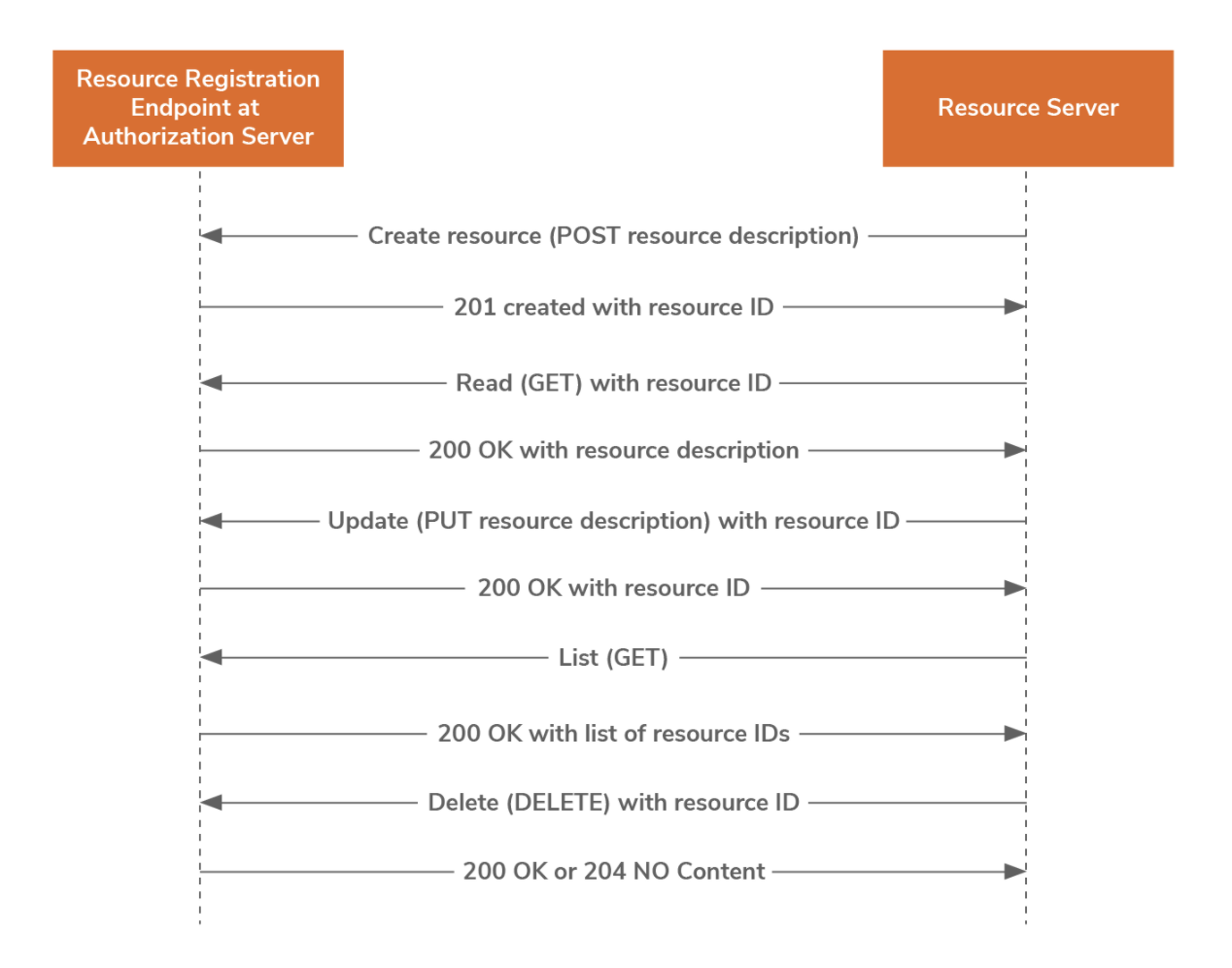Resource Registration Endpoint¶
This document describes the purpose, parameters, and flow of the resource registration endpoint of the protection API in UMA 2.0.
What is the resource registration endpoint?¶
This endpoint allows the resource server to place resources under the protection of the authorization server on behalf of the resource owner. The resource server uses a RESTful API resource registration endpoint at the authorization server to create, list, read, update, and delete resources and resource descriptions.

What is a resource description?¶
A resource description is a JSON object that explains the characteristics of the resource that is to be put under the protection of the authorization server. It consists of JSON documents that are maintained as web resources. Generally, the protection of a resource starts with successful registration and ends with successful deregistration.
Given below is an example of the resource description.
{
"resource_scopes":[
"view",
"http://photoz.example.com/dev/scopes/print"
],
"description":"Collection of digital photographs",
"icon_uri":"http://www.example.com/icons/flower.png",
"name":"Photo Album",
"type":"http://www.example.com/rsrcs/photoalbum"
}Resource description parameters¶
The resource description has the following parameters:
| Parameter | Description | Mandatory/Optional |
|---|---|---|
resource_scopes |
A plain string, a URI, or an array of strings which indicates the available scopes for the resource. | Mandatory |
name |
A human-readable string naming the resource. The authorization server can use the referenced icon in the user interface when presenting information to a resource owner. | Mandatory |
description |
A human-readable string describing the resource in detail. The authorization server can use this description in the user interface when presenting information to a resource owner. | Optional |
icon_uri |
A URI for a graphic icon representing the resource. The authorization server can use the referenced icon in the user interface when presenting information to a resource owner. | Optional |
type |
A string identifying the semantics of the resource. The authorization server can use this information when processing information about the resource or displaying information about it in the user interface when presenting information to a resource owner. | Optional |
Resource registration APIs¶
The authorization server must support performing the following five operations. A valid Protection API Access Token (PAT) is required in order to access them.
Info
resourceregistration stands for the resource registration endpoint and _id stands for the authorization server-assigned identifier for the web resource (which corresponds to the resource at the time it was created), included within the URL returned in the location header.
| HTTP method | Description | URI |
|---|---|---|
POST |
Create the resource description. | resourceregistration/resource |
GET |
Read the resource description. | resourceregistration/resource/_id |
PUT |
Update the resource description. | resourceregistration/resource/_id |
DELETE |
Delete the resource description. | resourceregistration/resource/_id |
GET |
List the resource descriptions. | resourceregistration/ |
Create a resource description¶
This operation adds a new resource to the authorization server using the POST method. If the request is successful, the resource is registered in the authorization server and the 201 (Created) status message, which includes a location header and an _id parameter, is returned. A sample request and response are shown below.
Request
POST : https://localhost:9443/api/identity/oauth2/uma/resourceregistration/v1.0/resource HTTP/1.1 Content-Type: application/json
Authorization: Bearer 8ff019ba-4f8e-3ed9-9b13-a077d9d04557
...
{
"resource_scopes":[
"read-public",
"post-updates",
"read-private",
"http://www.example.com/scopes/all"
],
"icon_uri":"http://www.example.com/icons/photoAlbem.png",
"name":"PhotoAlbem",
"type":"http://www.example.com/rsrcs/socialstream/140-compatible"
}Response
HTTP/1.1 201 Created
Content-Type: application/json
Location: /resource/2292d2f5-df72-4c2e-a918-5ae18b900855
...
{
"_id":"2292d2f5-df72-4c2e-a918-5ae18b900855",
"user_access_policy_uri":"http://as.example.com/rs/222/resource/KX3A-39WE/policy"
}Read a resource description¶
This operation reads the previously registered resource description using the GET method. If the request is successful, the response returns the 200 (OK) status message with a body that contains the referenced resource description along with an _id parameter. A sample request and response are shown below.
Request
GET: https://localhost:9443/api/identity/oauth2/uma/resourceregistration/v1.0/resource/2292d2f5-df72-4c2e-a918-5ae18b900855
HTTP/1.1 Content-Type: application/json Authorization: Bearer 8ff019ba-4f8e-3ed9-9b13-a077d9d04557Response
HTTP/1.1 200 OK
Content-Type: application/json
...
{
"_id":"2292d2f5-df72-4c2e-a918-5ae18b900855",
"resource_scopes":[
"read-public",
"post-updates",
"read-private",
"http://www.example.com/scopes/all"
],
"icon_uri":"http://www.example.com/icons/PhotoAlbem.png",
"name":"PhotoAlbum",
"type":"http://www.example.com/rsrcs/socialstream/140-compatible"
}Update a resource description¶
This operation updates the resource description. It replaces the previous description with the new description using the PUT method. If the request is successful, it returns 200 (OK) as the response from the authorization server and it includes the _id parameter. A sample response is shown below.
Request
PUT : https://localhost:9443/api/identity/oauth2/uma/resourceregistration/v1.0/resource/
2292d2f5-df72-4c2e-a918-5ae18b900855
HTTP/1.1 Content-Type: application/json
Authorization: Bearer 8ff019ba-4f8e-3ed9-9b13-a077d9d04557
...
{
"resource_scopes":[
"http://photoz.example.com/dev/scopes/view",
"public-read"
],
"description":"Collection of digital photographs",
"icon_uri":"http://www.example.com/icons/nature.png",
"name":"Photo Album 90",
"type":"http://www.example.com/rsrcs/photoalbum90"
}Response
HTTP/1.1 200 OK
...
{
"_id":"2292d2f5-df72-4c2e-a918-5ae18b900855"
}Delete a resource description¶
This operation removes a previously registered resource and its information. If the request is successful, the authorization server responds with an HTTP 200 or 204 status message.
Request
DELETE : https://localhost:9443/api/identity/oauth2/uma/resourceregistration/v1.0/resource/
2292d2f5-df72-4c2e-a918-5ae18b900855
HTTP/1.1 Content-Type: application/json Authorization: Bearer 8ff019ba-4f8e-3ed9-9b13-a077d9d04557Response ``` xml HTTP/1.1 204 No content ...
```
List resource descriptions¶
This operation lists down all the resources of a specific resource owner using the GET method. If the request is successful, a response in string array format is returned. A sample request and response are shown below.
Request
GET : https://localhost:9443/api/identity/oauth2/uma/resourceregistration/v1.0/resource
HTTP/1.1 Content-Type: application/json
Authorization: Bearer 8ff019ba-4f8e-3ed9-9b13-a077d9d04557Response
HTTP/1.1 200 OK
...
[
"2292d2f5-df72-4c2e-a918-5ae18b900855",
"d163001d-e8ec-4b11-b89e-7c5d891e878e",
"3a62e677-4bd9-4dfb-87b6-c305ec17b339",
"763bc9cf-3753-44e8-ba86-389b9913f971"
]Error messages¶
When the request to the resource registration endpoint is incorrect, the authorization server responds as follows:
| Error Code | Description |
|---|---|
| HTTP 404 (Not Found) | If the referenced resource cannot be found, the authorization server must respond with an |
| HTTP 405 (Method Not Allowed) | If the resource server request used an unsupported HTTP method, the authorization server must respond with the |
| HTTP 400 (Bad Request) | If the request is missing a required parameter, includes an invalid parameter value, includes a parameter more than once, or is otherwise malformed, the authorization server must respond with the |